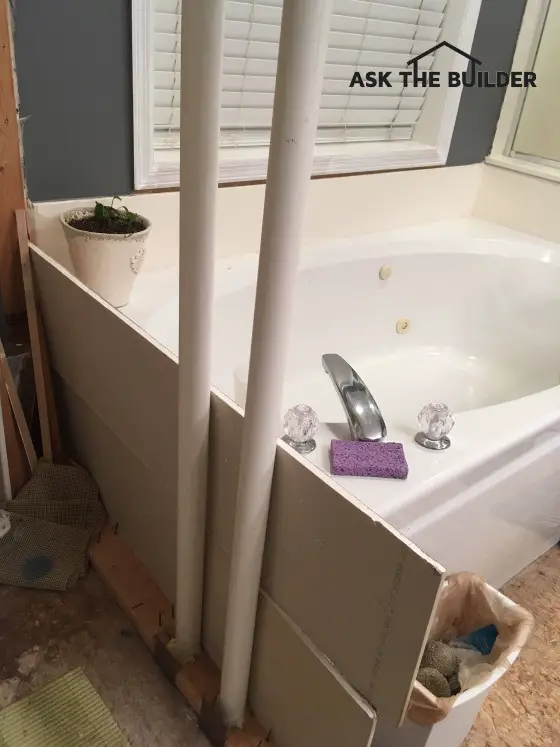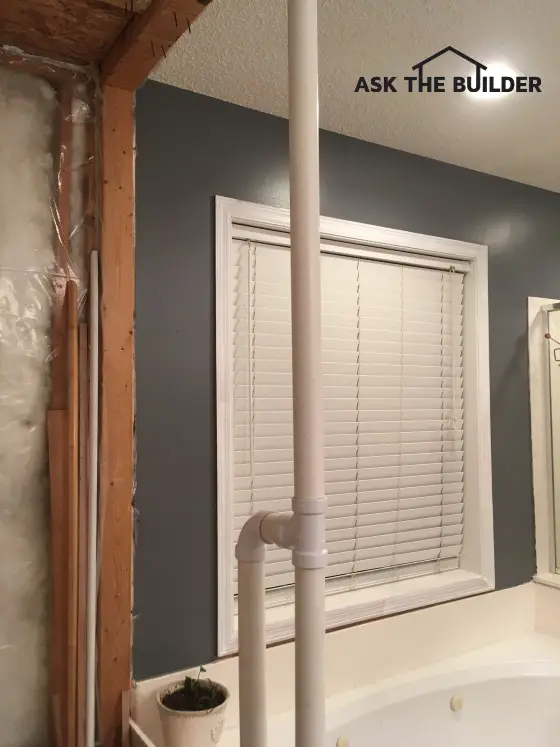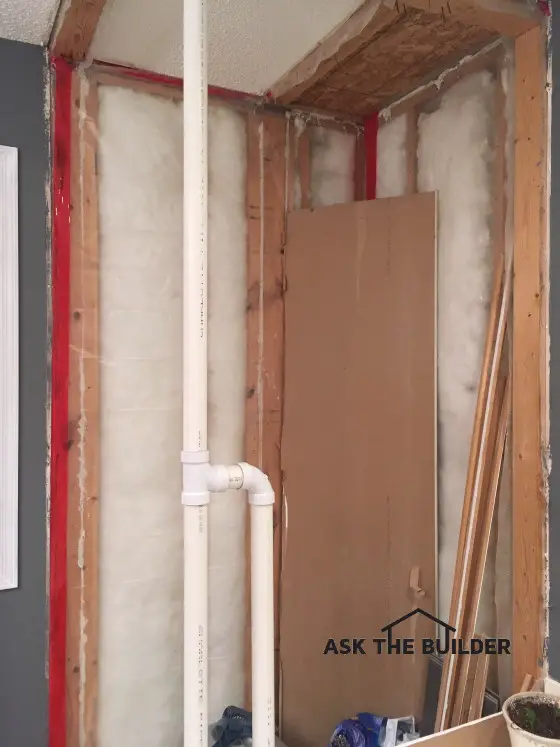Move Pipes in Wall

Move Pipes in Wall | Beware advice from some handymen and plumbers saying you can’t relocate these vent pipes. They’re wrong. Copyright 2020 Tim Carter
QUESTION: Tim, I need you to weigh in on a remodeling conundrum. Two plumbers and one handyman say that two plumbing vent pipes can’t be relocated to an exterior wall. I took the drywall off the back of a linen closet to open up the space for my soaking tub. I want to have extra space for candles and wine bottles. I live where it can get really cold and they say this can be a problem. Do you know anything about plumbing? Can the vent pipes be moved, yes or no? Can I just cap them off below the floor? Also, what about moving wires and ductwork? Can that be accomplished? What’s involved when moving all these utilities? Suzanne B., Minneapolis, MN
Have you experienced that “Uh oh” moment at some point in your remodeling escapades over the years? You know, when you gleefully start to tear down a wall and find all sorts of unexpected things going up through and between the wall studs?
How easy is it to relocate pipes?
The fast answer for Suzanne is the vent pipes can be moved. I can say this with a considerable amount of authority as I’ve been a master plumber since age 29. The follow-up question might have been, “Tim, how easy will it be to relocate the pipes?”
That question can only be answered by a visit to the job site to see what framing is in the way and what additional demolition needs to be done to create a pathway that will allow the vent pipes to drain any condensate back into the drainage part of the plumbing system. Local codes may require the vent pipes be put in certain walls. That’s up to your local inspector.
CLICK or TAP HERE to get FREE BIDS from local plumbers that can move vent pipes or water lines.
Can you cap off a vent pipe?
Never cap off vent pipes. These pipes are vital as they deliver air into the plumbing system. Most people think that the plumbing vent pipe up on the roof is like a factory chimney that exhausts smoke. Vent pipes work in reverse. They deliver air down into the system each time you flush a toilet, drain a sink, or run water into a fixture. The moving water not only pushes air ahead of it as it travels to a septic tank or sewer, but it can also create a vacuum as a slug of water passes a drainage branch within the system.

You can see the two vent pipes combine to become one. You can move these to the exterior wall in almost all cases.
Why do vent pipes need to be sloped?
Vent pipes need to be installed just like regular plumbing drain pipes. They need to have a slope so that any condensation that does form in the pipes can drain by gravity into the plumbing system on its way to the septic tank or sewer. This same condensation can be a pesky problem in cold climates as hoarfrost can choke off a vent pipe. This is why in very cold climates the main vent stack is often full-sized and a 4-inch-diameter pipe. The larger pipe size means that much more frost must form to choke off the air supply.
Can vent pipes be installed on a cold exterior wall?
Vent pipes on exterior walls in cold climates should be located in such a way as to be as far from the cold exterior wall surface as is reasonably possible. You want as much insulation space between the pipe and the outer wall to hopefully keep the pipe temperature just above freezing.
Can electrical wiring be relocated?
Electrical wiring can also be relocated in a remodeling job. There can be significant challenges and the paramount thing you must realize is you or a worker should never ever bury a junction box. If you have to create a splice to add additional wiring, the junction box must be visible. You can often achieve this in a closet.
I always wrote a note and included a small drawing in the junction box of what had to be done to move the cable. Trust me when I say a future electrician will cherish reading this note. It might help him diagnose some future problem within the circuit as he’d have no idea that remodeling work might have happened fifty years prior.

Are HVAC ducts hard to relocate?
Heating and cooling ductwork is, by far, the hardest thing to relocate. The size of the pipes and ducts in the first challenge. The second more sinister issue is poor performance because extra fittings and ductwork need to be added to make the change.
The addition of a 90-degree bend to a typical heating or cooling duct line is like adding ten extra feet of pipe. The air moving through a heating or cooling duct is very sensitive to extra friction caused by additional fittings or pipe. More friction equals less conditioned air being delivered to the room where it’s needed.
Be sure to have a frank discussion with your HVAC professional about this if the room being served by the ductwork is currently on the edge of being comfortable in extreme hot or cold weather.
Will photographs during construction help future remodeling?
If you’re building a new home or a large room addition, you can do yourself, remodeling contractors, and future homeowners a huge favor. Try to take as many photos of all the walls, ceilings, and floors in your new home or room addition as possible before utilities are covered with drywall or insulation. Store these photos on a simple storage device like an SD card or micro-SD card. These are so very inexpensive and can hold thousands of photos.

This is a micro SD card as of October 2020. Who knows what we'll be using in 2030! CLICK on THE IMAGE to order one.
Put this memory card in a plastic bag and label it. Tape this bag to the front or inside cover of the circuit-breaker panel. You have no idea how valuable these photos will be to someone in the future and they’ll toast you that day at lunch or dinner!
Column 1377